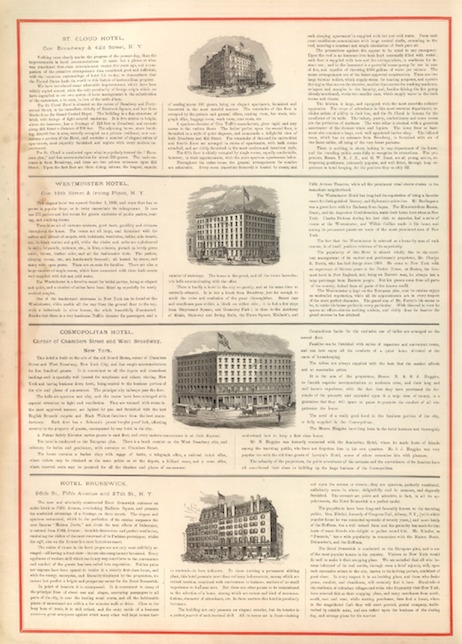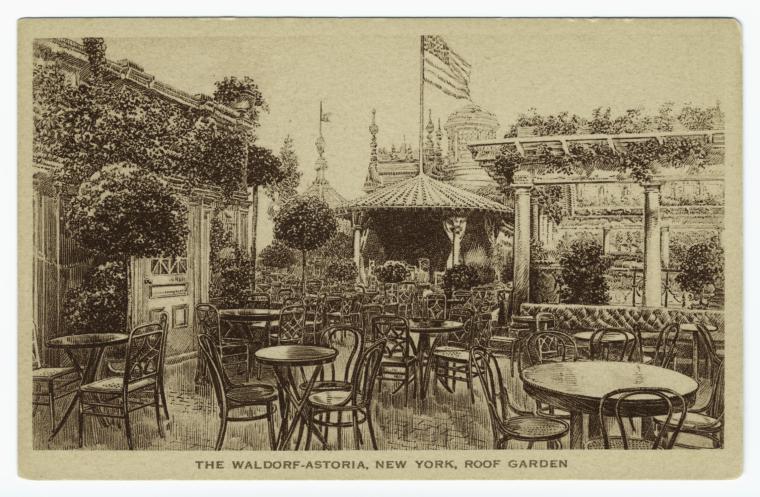Progress and nostalgia

New York City hotels: St. Cloud, Westminster, Cosmopolitan, and Hotel Brunswick. Asher and Adams Atlas, 1875.
Martin Dressler’s early hotels clearly reflected the hotels in New York City during the early years of the progressive era. The Asher and Adams Atlas stated in 1875 that: “Nothing more clearly marked the progress of the present day than improvements in hotel accommodations”. Hotels in New York City were among the first businesses to incorporate the newest technology in their buildings.
Historic Hotels of America states that in 1893, the Waldorf Astoria offered complete electricity and private bathrooms. Similarly, Martin recognized technology as a necessity of the modern hotel while working at the Vanderlyn: “people liked telephones and new electric elevators and private toilets and incandescent lights” (70). Millhauser’s repetition of “and” emphasized the abundance of new technological inventions that residents wanted wherever they were staying. By creating this conjunctive list with no verbs, each item is individually stressed implying that people really wanted the luxury of all of these technologies. That being said, Martin had the insight that residents wanted modern technologies combined with nostalgic décor. He continued “…but at the same time they liked old world architecture, period furniture, dim suggestions of the very world that was being annihilated by American efficiency and know how” (70). Millhauser’s use of the word annihilated harshly portrayed America’s powerful and rapid development and implies how quickly the city was changing due to the revolutionary innovators of the time. Architectural trends have been known to last longer than other cultural trends, and décor styles were clearly one of the only remaining features that lasted through the transitioning progressive period.
Actual New York City hotel features inspired Martin’s integration of traditional and the modern concepts. One example was in The Westminster Hotel, which combined elevators, steam heat, and hot and cold water with an old world white marble staircase with silver bronze balustrade (Asher & Adams). In addition, in the Scientific American periodical in 1897, a description of the architecture of the Waldorf Astoria Hotel explained: “The external treatment follows the school of the German Renaissance, which style also characterizes much of the interior, though most of the rooms are designed in the style of the Italian and French Renaissance” (Construction of the Astoria Hotel, New York City). The Waldorf Astoria combined old European style design with the latest technological improvements as described in Scientific American: “The equipment of electrical signals, annunciator bells, telephones, etc., is one of the most, if not the most, elaborate in the world”. This combination attracted residents because they did not like change, but they wanted efficient technologies that made living more comfortable. The rapid progression of technology and new inventions during the Gilded Age filled the period with constant radical change to the extent that the development of the New York City had a surreal quality. Martin’s fictional character’s ability to understand how to perfectly integrate traditional values with new concepts revealed how challenging of a task the actual New York City entrepreneurs had during this transitioning time. Martin concluded: “People wanted the paradoxical, the impossible and it was the Vanderlyn’s job to provide it” (70). People wanted the best of both worlds, and Millhouser’s description of the paradoxical as the impossible emphasized the complexity of people’s desires that the New York City entrepreneur’s were able to exceptionally fulfill.
One of the themes underlying the integration of complex systems in Martin’s Hotel’s and actual New York City Hotels was to bring together all of the luxuries of the city into a hotel. Martin explained: “His own dream was to push the New Dressler beyond the limits of the old, to express in a single building what the city was expressing separately in its hotels and skyscrapers and department stores” (235). This revolutionary time allowed Martin and New York City entrepreneurs to push the hotel industry in a new direction. In addition to incorporating the man made convenient features, both Martin and New York City entrepreneurs focused on bringing natural elements to the inside of their hotels. The parks in the city allowed people to escape from the bustling noisy chaos, and Martin and George Boldt both incorporated this concept in their own hotels through a roof garden. Martin explained his creation in The Dressler:
The roof garden was itself a popular spot, with its railed promenade, its flower gardens and small orchard of fruit trees, its scattering of gazebos and Swiss chalets, its red and blue and green Japanese lanterns and its open air restaurant of small canework chairs beneath a roof supported by white wooden posts joined by scrollwork. (217-218)
Millhauser’s excessive attention to detail in this list further defined how true to life Martin’s ideas and creations were to the Progressive Era. The image combining each color and characteristic of the garden creates an exceptional impression of realism. Consequently, the actual roof garden in the Waldorf Astoria perfectly exemplifies Martin’s vision. The "Waldorf Astoria, New York, Roof Garden" photomechanical print from the Art and Picture Collection of the New York Public Library illustrates the roof garden at the Waldorf Astoria hotel. The garden being on the roof incorporated an old suburbia feel to the new construction of towering buildings. It allowed residents to escape from the city in a brand new way exemplifying the integration of a complex system successfully satisfying resident’s needs.

